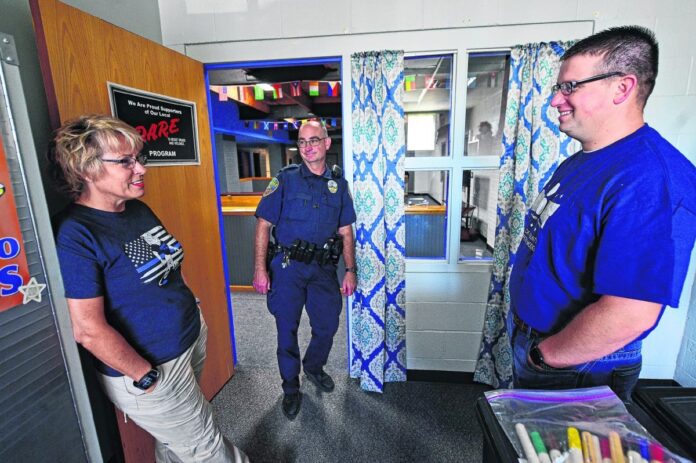
HANCOCK COUNTY — Helping young students make good decisions is right up Kyle Addison’s alley.
When Addison, a Hancock County sheriff’s deputy, was a youngster, he was a role model student for the county’s Drug Abuse Resistance Education program. Now, as he serves the public in his career as a law enforcement officer, he is helping young people again as a new instructor in the D.A.R.E. program.
“It’s a whole different animal than what an officer is used to as far as dealing with kids,” Addison said.
[sc:text-divider text-divider-title=”Story continues below gallery” ]
Law enforcement officers are trained mostly to be a reactive force, but D.A.R.E. officers are taught to be proactive, going into the schools and educating fifth-grade students about alcohol, drugs and violent behavior before they have a chance to get in trouble.
To become a part-time D.A.R.E. officer, Addison went through two weeks of specialized training and is now able to go into county schools to help educate students about making good decisions when it comes to risky behavior.
Sgt. Christine Rapp of the Hancock County Sheriff’s Department is in charge of the county’s D.A.R.E. program, something she’s been a part of for the past 20 years. Entering the 21st year of the program, adding Addison will give the program a chance to expand, Rapp said.
The program now has three officers.
“It’s a lot of work, so it’s got to be an officer who really enjoys working with young kids because they can be a handful, and Kyle can handle that,” Rapp said.
Rapp, who has been with the sheriff’s department for over 30 years, said the biggest part of the D.A.R.E. program is building relationships with students and parents. Addison, she said, has the right temperament and wants to see kids succeed.
Addison joins veteran D.A.R.E. officer Cpl. Steve McCarley of the Greenfield Police Department, who teaches in the Greenfield-Central schools. Rapp works with the other county schools, and Addison can now help her.
The program, which is ever-changing, Rapp noted, has a goal to prevent use of drugs and alcohol; membership in gangs; and violent behavior. Making connections early and often is key. Officials want to expand the program to include seventh-graders. Adding Addison to their teaching schedule will help them be able to do that.
“Out of a 180-day school year, I’m probably teaching about 150 days, so bringing Kyle on board we can hopefully add the middle and even a high school component,” Rapp said.
Since D.A.R.E officers go into individual classrooms to speak, they don’t believe COVID-19 protocols will prevent them from going to the schools and teaching students this school year.
Kristie Satterfield, a teacher at Brandywine Elementary School, is a D.A.R.E. program adviser — a member of the training team who instructed Addison in the program’s curriculum.
It’s great to have officers like Addison, she said, who are invested in the community to be role models and instructors in local schools, but it’s a very different type of training for the officers.
“To work with kids, it requires a very special skill set,” Satterfield said. “Working with students is not what they are used to in law enforcement.”
Satterfield said it’s commendable when officers choose such an important assignment.
“I am very proud of him and know that he will do a fantastic job delivering the D.A.R.E. message to our Hancock County youth,” Satterfield said of Addison.
D.A.R.E. programs are based on Socio-Emotional Learning Theory, or SEL, Satterfield said. The program overs young people strategies to help them make healthy life choices with confidence. Learning such skills are important for children facing a rapidly changing world, proponents say.
“The program helps students know that we have positive expectations for them,” Satterfield said.
She’s had several former students tell her they remember the lessons they learned when they were in the D.A.R.E. program. One of the great side effects of the program is it promotes connections between police officers and students and helps build positive relationships.
“These officers are in a perfect position to be an asset for our children in schools,” Satterfield said.
The biggest take-away for Addison, a father of two young children, is that he has learned D.A.R.E. is a more than a “say no to drugs” program. Officers base their teachings on proven educational programs to help students make good decisions for anything in life.
Addison is in his 10th year with the sheriff’s department and was happy to volunteer to be a part of the D.A.R.E. program, he said. As a former local coach and substitute teacher who loves working with elementary-aged kids, the D.A.R.E. program is suited for him, he said.
“I like working with kids,” he said. “I really do, especially the younger, elementary-aged kids, seeing them get things and understand. That’s pretty neat.”
[sc:pullout-title pullout-title=”What is D.A.R.E? ” ][sc:pullout-text-begin]
Drug Abuse Resistance Education is designed to give kids the skills they need to avoid involvement in alcohol, drugs, gangs and violence.
D.A.R.E. was founded in 1983 and has been implemented in thousands of schools throughout the United States and More than 50 countries.
Los Angeles Police Chief Daryl Gates and the Los Angeles Unified School District the program.
A 1998 study noted a 50% decreased likelihood of high-risk drug use among students who participated in the D.A.R.E. program.
Source: DARE.org
[sc:pullout-text-end]



